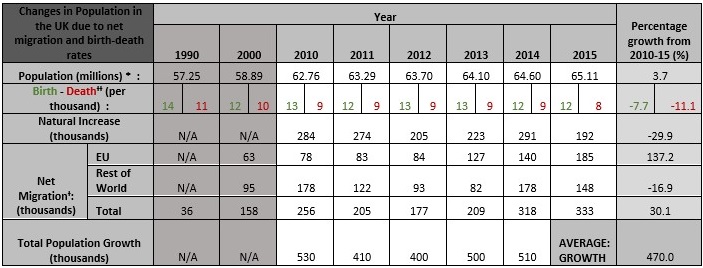Work Experience student Christopher Wilkin also investigated the 'hot topic' of immigration looking at its contribution to the UK economy and its effects on population growth.

In 2015, over half of the UK’s population growth came from immigration alone, with a net total of over 333,000 migrants entering the country. These immigrants can have both positive and negative impacts on our economy, but why is this, and what effects do they have?

How immigrants aid population growth
Over the past five years, the population of the United Kingdom has increased gradually with an average increase of 0.74% per annum. In 2010, the population according to the ONS was 62.76 million, but in just five years, it has grown to 65.11 million. This does not tell the whole story, however, as the population growth recently has been hugely affected by both changes in the Natural Increase, as well as a drastic increase in net inward migration.
In 2010, the UK received a net gain of 256,000 people purely from migration. While this was slightly lower than the natural increase of 284,000, the quantity of migrants coming into the country was higher than ever seen before. To put this into perspective, the UK received only 158,000 migrants in 2000, a hundred thousand less than in 2010, and in 1990, there were just 36,000 migrants entering our country. This demonstrates the huge increase in migration into the UK over the past few decades, reaching a peak of 333,000 in 2015. This has made up an increasingly large proportion of the UK’s population increase. While from 2010 to 2013 the net migration numbers were still lower than the natural increase values, they recently overtook in 2014 to make up more than half of the UK’s population growth. In 2015, the population grew only 192,000 from natural increase. The additional increase of 333,000 from net, world-wide migration into the UK brought the growth up to a huge half a million people.
Furthermore, as can be seen by the birth - death rates, as well as the natural increase figures, the natural increase in the UK is currently dropping, having decreased by nearly 30% over the past five years. While the difference between the death and birth rates has remained relatively constant, both birth and death rates have dropped by two or three people per thousand over the past 30 years. This suggests that in the near future, it is likely that both rates will drop even further, reducing the natural increase of the UK even more significantly.
This illustrates how migration into the UK, especially from Europe due to the free movement rules governing the European Union countries, now makes up a larger percentage of the UK’s population growth than natural increase does.

The data also shows the change in net migration to the UK from both EU and non-EU parts of the world. Un-surprisingly, since the creation of the European Union in 1993, the number of EU migrants entering the UK has increased exponentially, rising by 137% just over the past five years – more than doubling, making up the vast majority of the total net migration into the UK. In contrast, however, the data shows a negative trend for migration from the rest of the world. Since 2010, the number of non-EU migrants moving to the UK has dropped by nearly 17% and since 2012, they have made up less than half of the total net migration for those years. The drop in non-EU migration could be accredited to a number of different causes.
One of these is the array of policies that the recent governments have put in place to do with immigration. As the government has most control over non-EU migration, the majority of its attempts to reduce net migration into the UK are focused on this category. Changes such as increasing accreditation requirements for non-EU students who wish to study in the UK have drastically reduced the number of non-EU migrants being allowed into the country, resulting in the drop shown in the data. As the government, pre-Brexit, had very little control over EU migrants, the net EU migration has continued to rise in contrast to the non-EU migration rates. Despite non-EU migration rates dropping, the EU based migration figures have increased at such a rate that the total net migration into the UK from the whole world currently is still up 30% since 2010.
How immigrants affect the UK’s economy
Migration into the UK can have both positive and negative impacts on our society, depending on the origin of the immigrant, the contribution made to the community, and the skills that they provide for industries.
Migrants that enter the UK are typically quite young, either students or young adults looking for a better-paid job and good working conditions. While it does happen that migrants bring dependants to the UK, the general trend suggests that more migrants result in a stronger labour force. Many migrants from LEDCs are more willing to work as manual labourers, helping on farms and construction sites, than most British citizens. Additionally, due to the inferior conditions that many immigrants originate from, they are much cheaper to employ, saving companies and firms lots of money on salaries. However, many people take the view that immigrants ‘steal’ their jobs. This is because, as the UK already has an unemployment rate of over 5%, the volume of immigrants currently entering the UK can only increase this, resulting in strong, negative views on immigrants being held by much of the British UK population.
Due to the raising of non-EU accreditation requirements, many migrants that arrive from countries such as India, China often have very high qualifications. With the NHS being the largest employer in the UK with 1.2 million employees, a survey showed that over 5% of these were immigrants. Furthermore, just over a third of all doctor applications for the NHS came from non-EU migrants, and under a third came from British UK citizens. This clearly demonstrates the significant proportion of UK jobs held by immigrants, explaining why so many people view immigrants in such a negative light.
However, I think that the positive impacts of migration into the UK strongly outweigh any superficial negative views, and that the contributions made by them, such as an increase of £4 billion of GDP from migrants in the UK, make migration a valuable asset.
To conclude, it is clear from the data that net immigration levels into the UK have increased dramatically over the past years. Despite the reduction of non-EU migrants, the increase of EU migrants has still brought net migration to make up more than half of the UK’s yearly population growth. And with the UK’s natural increase decreasing over time due to lower birth and death rates, the continuous integration of new migrants into our communities makes a valuable contribution to the UK’s economy.
Sources:
*Population sourced from:
**Population predictions from:
http://www.prb.org/pdf15/2015-world-population-data-sheet_eng.pdf
ᶧMigration sourced from:
http://www.migrationwatchuk.org
ᶧᶧBirth and Death rates from: